
Volume 10 - Autumn 2000
About Paper Grain
by Richard P.Grant
One of the most important paper properties of interest to the bookbinder is paper grain. If grain direction is ignored, it can cause any number of problems with paper distortion in the finished book. Most bookbinders think of paper grain as a difference in expansion properties between the length and width of a paper sheet that is caused by an alignment of the paper fibres in the grain direction. Virtually all bookbinding texts refer to the grain in relation to the orientation of the paper fibres. This explanation, however, overlooks a more dominant mechanism at play in most papers, hand-made or machine-made. A deeper understanding of the true causes of paper grain can be useful in controlling various types of paper distortion and curl.
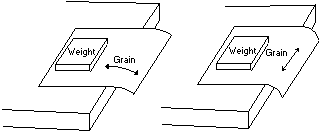 Figure
1 - Droop test for determining grain direction
Figure
1 - Droop test for determining grain direction
The direction of paper grain can be determined by the “droop” test as shown in Figure 1. A piece of paper is placed on the edge of a table so that a fixed distance, say six inches, protrudes over the edge. The angle of droop is noted and the paper is turned 90 degrees and extended the same distance again. The orientation that shows the greatest droop has the grain aligned with the table edge. For this to work, the distance from the unsuspended paper edge to the table edge must be the same for both directions. The length of the paper sample doesn't matter because the droop per unit length is constant.
 Figure
2 - Relative wet expansion of machine-made paper
Figure
2 - Relative wet expansion of machine-made paper
Another method for determining the direction of paper grain is useful in explaining why it can be troublesome. Paper expands more across the grain than with it (Figure 2). On machine-made papers, the ratio can be 10:1 or more. To determine the direction of grain, cut a square of paper about two inches on a side, then wet one side with water (Figure 3). The paper will curl with the valley or axis of curl in the grain direction since most of the expansion is in the cross-grain direction. This test works best with sized papers because the water penetrates the paper slowly enough to cause a difference in expansion rates between the two sides.
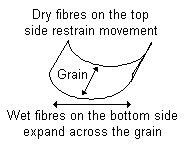 One
practical example of using the different expansion characteristics to best
advantage is in the preparation of pastedowns in a book. If the grain is oriented
parallel to the spine, expansion after paste application occurs mainly across
the width of the book (Figure 4). If, however, the grain is perpendicular
to the spine (Figure 5), expansion is mostly head to tail. Since the expanded
wet pastedown is constrained at the dry spine, the paper distorts and forms
wrinkles. Although the wrinkles recede somewhat upon drying and shrinking,
there usually is too much that remains to be considered a neat job.
One
practical example of using the different expansion characteristics to best
advantage is in the preparation of pastedowns in a book. If the grain is oriented
parallel to the spine, expansion after paste application occurs mainly across
the width of the book (Figure 4). If, however, the grain is perpendicular
to the spine (Figure 5), expansion is mostly head to tail. Since the expanded
wet pastedown is constrained at the dry spine, the paper distorts and forms
wrinkles. Although the wrinkles recede somewhat upon drying and shrinking,
there usually is too much that remains to be considered a neat job.
Figure 3 - Wet curl test for paper grain
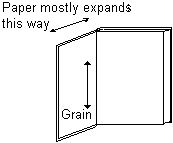 Figure
4 - Grain parallel to spine
Figure
4 - Grain parallel to spine
Figure
5 - Grain perpendicular to spine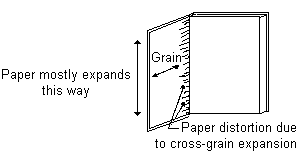
The mechanism of grain formation
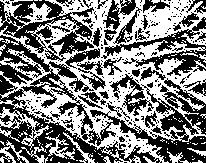 Paper
grain arises from two basic mechanisms: fibre orientation and dried-in strain.
In any machine-made paper I have been associated with, mostly fine papers,
the grain comes almost exclusively from dried-in strain. Fibre orientation
is almost completely random as seen in Figure 6. If a paper machine is brought
to a crash stop and samples are taken from the wet end through to the finished
paper at the dry end, and those samples are allowed to dry freely on mesh,
the paper grain from samples taken from the wet end will have no grain while
those taken progressively through the machine will have increasing amounts
of grain to a maximum at the wound roll of paper.
Paper
grain arises from two basic mechanisms: fibre orientation and dried-in strain.
In any machine-made paper I have been associated with, mostly fine papers,
the grain comes almost exclusively from dried-in strain. Fibre orientation
is almost completely random as seen in Figure 6. If a paper machine is brought
to a crash stop and samples are taken from the wet end through to the finished
paper at the dry end, and those samples are allowed to dry freely on mesh,
the paper grain from samples taken from the wet end will have no grain while
those taken progressively through the machine will have increasing amounts
of grain to a maximum at the wound roll of paper.
Figure 6 - Photomicrograph of machine-made paper
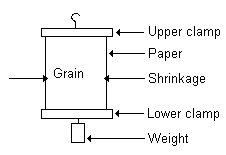 Figure
7 - Paper constrained while drying develops 'grain'
Figure
7 - Paper constrained while drying develops 'grain'
Where does this grain come from? It can't be fibre orientation since it doesn't change significantly from one end of the machine to the other. Other more sophisticated tests confirm that fact. It must be the way the paper is dried. In fact, if the wet end samples are dried under constraint in a laboratory, they will develop "grain" if constrained in one direction only (Figure 7). Machine made paper is constrained in the direction of manufacture because it is pulled through the machine. It is not constrained in the cross direction and is free to shrink as it is dried (Figure 8). Once it shrinks, it is more prone to expand upon re-moistening.
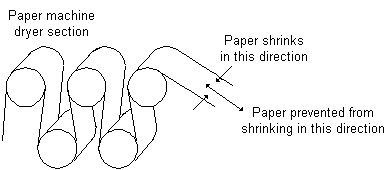 Figure
8 - Constrained and unconstrained drying on a paper machine
Figure
8 - Constrained and unconstrained drying on a paper machine
I like to think of paper as being composed of a lot of tiny springs that have been stretched to different degrees. When paper is dried, they become "frozen" in position. When the paper is remoistened, they can relax somewhat and try to return to their unstretched state. Cellulose, like plastic (and taffy) is viscoelastic, that is, it has a tendency to flow under tension. This will release tension over time. Moisture is a great plasticiser and the higher the moisture, and also temperature, the faster the flow and stress relief. Humidity cycling as with the seasons or even the day-night cycle work to release these stresses over time.
If you have a sample of Mohawk Superfine or similar paper which has not been heavily pressed or calendered during manufacture, look at the surface with a low angle light first in the machine direction, then in the cross direction. When the light shines across the grain, you can easily see the large scale grain which looks like grains of rice with the axis in the machine direction. This grain is caused by tiny puckers that form when the sheet shrinks in the cross direction. These tiny deformations make the sheet less stiff in the cross direction since they act somewhat like accordion bellows. Smaller scale grain that also contributes to stiffness differences can't be seen without an electron microscope.
Hand-made paper can have some oriented fibres depending on how the mould is manipulated. As the water drains through the screen, the screen can act as a comb and drag the fibres in one direction. Usually, though, this kind of paper has less grain because it is not constrained along one axis while dried. The fact that much hand- made paper has less grain although the possibility exists that the fibres could be more oriented again points to the importance of the drying method in contributing to the grain mechanism.
Dried-in strain and paper distortion
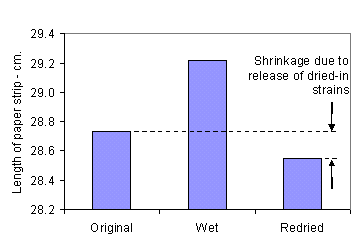 Figure
9 - Mohawk Superfine 80 lb cross-grain strip dimensional changes after wet
and re-dry
Figure
9 - Mohawk Superfine 80 lb cross-grain strip dimensional changes after wet
and re-dry
Many types of paper distortion including moisture-induced curl and cockle are directly related to dried-in strain. The strains that have been locked into the paper by drying under tension can be partially released by humidity cycling or wetting and redrying. A cross-grain strip of Mohawk Superfine 80 lb. paper was measured before and after wetting and redrying (Figure 9). The redried length was 0.63% shorter than the original length, a typical change for many different kinds of paper. Dimensional changes with changes in moisture content can cause curl if there is a difference between paper sides (Figure 10). This implies that thoroughly wetting the sheet and then redrying without tension can reduce the amount of grain. In practice, however, paper sizing retards wetting and several wet/dry cycles are usually necessary to have a significant impact on the grain.
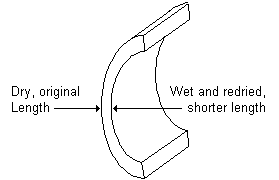 Figure
10 - Curl arising from non-uniform wetting
Figure
10 - Curl arising from non-uniform wetting
Curl can also be caused by uniform wetting but non-uniform drying. This can be used to advantage with some types of curl control. If a uniformly wetted paper sheet is exposed to a heat source like a light bulb that dries one side more rapidly than the other, curl will initially be toward the light (Figure 11a) because fibres on that side of the paper shrink and pull the paper. This places the fibres on the non-dried side under compression, however, and they are forced to slip and buckle slightly. When the second side of the paper dries (Figure 11b), it shrinks by the amount of the first side plus the additional caused by the compressive stresses. Its ultimate length is shorter than the first side causing curl to form toward the unheated side. Often the axis of curl flips 90 degrees as well. A general rule is that paper (and board) will curl toward the side dried last.
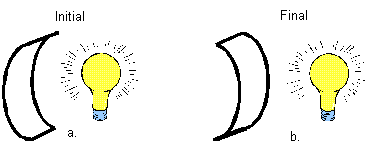 Figure
11 - Curl arising from non-uniform drying
Figure
11 - Curl arising from non-uniform drying
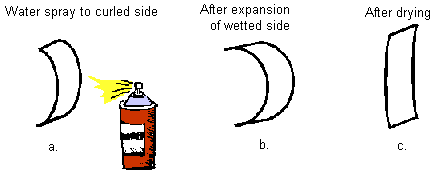 Figure
12 - Curl arising from non-uniform wetting and drying
Figure
12 - Curl arising from non-uniform wetting and drying
To control curl, the back side of the curled paper can be dampened with a water spray or light application of water from a sponge (Figure 12a). This is counterintuitive because the initial reaction is to cause even more curl (Figure 12b). The final result, however, is a curl reversal (Figure 12c), the amount depending on many factors like amount of water used, drying rate, type of paper or board, and amount of starting curl.
Most bookbinders appreciate that paper grain must be respected and that it should be oriented parallel to the spine. An understanding of the mechanism of grain formation and dried-in strains, however, is helpful with regard to control of curl and various types of paper and board distortion.
Richard P. Grant - Richard received a BS in Chemical Engineering and Pulp and Technology from the University of Maine. He retired from the corporate world after 31 years where he spent most of that time working in the field of paper physics with the manufacture of fine papers. Although his grandfather was a bookbinder, he did not bind books himself until 1997 when he began studying the craft of bookbinding.
